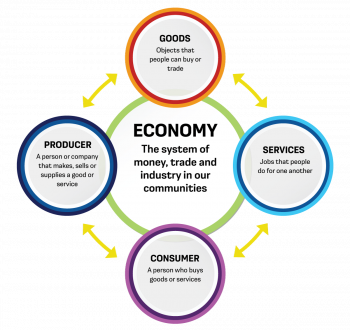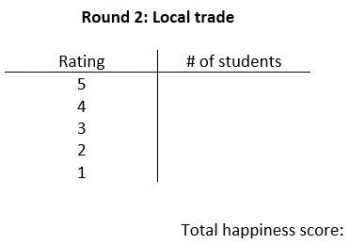
Introduce three key economic concepts: consumers and producers, goods and services, and trade. This hands-on game explores the benefits of trade.
Overview
Big Idea
Trade means exchanging something for something else. But it also happens when we buy and sell goods and services.
Total time
Approximately 60 minutes of instructional time, which could be delivered in one or two classes depending on class discussion.
Grade levels
Grades 3 to 5; Elementary cycles Two and Three
Subject area
Social studies
Learning objectives
Students will:
- define the terms consumer, producer, goods, services, local trade and global trade
- explain the economic relationships between consumers and producers
Materials
Classroom supplies and technology
- whiteboard and markers
- chart paper
- card stock
Trading cards
- Download and print the following:
- Trading cards — two copies
- Cut the cards so that you have 30 individual cards.
Online resources
For teacher reference:
- Murchison, S. and A. Chernoff. 2018. “Trading Up: How countries benefit from freer trade”. Bank of Canada The Economy, Plain and Simple. September 28.
Activity 1: Consumers and producers
Students will define the terms consumers, producers, goods and services.
Time
15 Minutes
1.1 Introduction
Ask your students a few questions to get them thinking about their roles as consumers:
- What was the last thing that you bought?
- Where did you buy it? Online, in a store, at a farmer’s market? Who sold it to you?
- Who made that item? Where was it made?
Explain to your students that by buying something they are taking part in the economy. The economy is the system of money, trade and industry in our communities and provinces, as well as in countries around the world.
1.2 Defining terms
Explain to your students that today we are going to learn some key words about the economy. These words might be new vocabulary for them, but they will understand the ideas because they are part of everyday life.
Write the word economy in the centre of a piece of chart paper. Ask your students to help you write a definition for economy, remembering what you explained in the introduction.
Goods and Services
The economy is made up of many moving parts. Explain to students the difference between goods and services.
Goods are objects that people can buy or trade. Examples of goods are a teddy bear, a video game and a chocolate bar.
Write the word goods in the middle of another piece of chart paper. Ask your students to help you write the definition for goods.
Services are jobs that people do for one another. Examples of services are cleaning, cutting hair, teaching and providing medical care.
Write the word services in the middle of another piece of chart paper. Ask your students to help you write the definition for services.
Ask the students to think about the last time they paid for something. Was it a good or a service?
Draw a t-chart on the white board and label the two columns “Goods” and “Services.” Ask students to write their answer in the correct column. If there are fewer goods than services or vice versa, invite them to come up with some more examples.
Consumers and producers
Explain to your students that when they pay for a good or a service, they are a consumer. A consumer is a person who buys goods or services.
Write the word consumer in the middle of another piece of chart paper. Ask your students to help you write the definition for
Explain to your students that the person selling them the good or service is a producer. This could be their hairdresser, a vendor at the farmer’s market or the person who sold them a video game. A producer is a person or company that makes, sells, distributes or supplies a good or service.
Ask your students:
- Have you ever made something to sell or trade to others, such as lemonade or friendship bracelets?
- In that case, you are a producer.
- Even if you are providing a service, like mowing the lawn your neighbour’s lawn, you are a producer.
- Each of us are both consumers and producers in our lives.
Write the word producer in the middle of another piece of chart paper. Ask your students to help you write the definition for producer.
1.3 Recap
Now you should have five pieces of chart paper with definitions on them. Stick the chart papers to a wall in the order shown below. Conclude with these terms by discussing how they are related. Draw arrows connecting the terms to each other.
Activity 2: Trade
Students will learn about local and global trade through a hands-on trading activity.
Time
45 Minutes
2.1 Opening discussion
Ask the class to come up with a definition of the word trade. Write this definition on another piece of chart paper. Trade means exchanging something for something else. But it also happens when we buy and sell goods and services.
Ask student:
- Have you ever traded something with someone else? What? Who? Why?
- What are the benefits of trade? What do you get out of it?
- If you trade for something that you want more, it can make you happier. It can also make your trading partner happier.
2.2 Hands-on exercise
Round 1: No trade
Students will play a game to simulate situations of no trade, local trade and global trade.
Hand out one trading card to each student. Ask them to think about the good represented on the card, and whether it’s something they would want. Ask them to say how happy they would be to have the object on a scale of 1 to 5, where 1 is unhappy and 5 is very happy.
Draw a t-chart on the board to record their answers.
Ask students to close their eyes. Ask whoever rates their good a 5 to raise their hand. Record the number of students who raise their hand. Ask whoever rates their good a 4 to raise their hand and record the number. Continue this until you have captured all the students’ answers.
Calculate the total happiness score by multiplying each rating number by the number of students who chose it (e.g., 5 x 10, 4 x 8, 3 x 4, 2 x 7, 1 x 2), writing this number on the appropriate t-chart row, and then adding the row totals together (e.g., = 110). This is the happiness score for this round.
Ask students to share some of the reasons why they gave the rating they did.
Round 2: Local trade
Tell the students that they will now have an opportunity to trade their card to see if they can get a good that makes them happier. But, they can only trade in a limited group. If they don’t want to trade they don’t have to.
Divide the students in groups of four. Make sure each group is in a different part of the classroom so that they are kept separate.
Allow three to five minutes for them to complete their trades. In the meantime, draw a new t-chart on the whiteboard.
After students have completed their trades, repeat the rating activity from Round 1 and record the answers. Complete the total happiness score. The total rating should have increased.
Ask students to share some of the reasons why they gave the rating they did.
Ask the class:
- Was it hard or easy to trade your card? Why?
- Were you able to get something you wanted more than your first card?
- What made you happier after your trade?
- One of the principles of trade is that no person will complete a trade that makes them less happy.
Round 3: Global trade
Tell the students that they are now going to trade their card with anyone in the class. They should see if they can find a good that will make them even happier. If they don’t want to trade they don’t have to.
Allow the students to trade with anyone in the class. This will be loud and chaotic as they try to figure out what others have. Give them five to eight minutes to complete their trades. In the meantime, draw a new t-chart on the whiteboard.
After students have completed their trades, repeat the rating activity and record the answers. Complete the total happiness score. The total rating should have increased.
Ask students to share some of the reasons why they gave the rating they did.
Ask the class:
- Was it hard or easy to trade your card? Why?
- Were you able to get something you wanted more than the card you had before?
- What made you happier after your trade?
2.3 Recap
Ask the class:
- Why did the happiness rating go up with each round?
- Why did allowing trade with a small group of people make people happier?
- You weren’t stuck with the good you received; you were able to trade for something you wanted more.
- This is called local trade, because you can only trade with people that are close to you.
Write the word local trade on another piece of chart paper. Ask your students to help you write the definition for local trade.
- Why did allowing trade with the whole class make people even happier?
- By increasing the number of people you could trade with, there were more choices for you to trade for, and more people who might want your good.
- This is called global trade, because you can choose who you trade with—in this case, in your class, but more broadly, the whole world.
- Global trade means that things can be traded between countries.
- Do countries work the same way?
- Countries don’t really trade with each other. Individuals and businesses in those countries trade with each other.
- The more people and businesses that are involved in trade, the more people in each country will benefit from the trade.
- Consumers benefit from more choice. Producers benefits from more customers. Just like when you did your trade—you benefited from having more choice and from having more people to trade your product with.
Write the word global trade on another piece of chart paper. Ask your students to help you write the definition for global trade.
Conclusion
Wrap up the lesson by recapping what was learned and repeating the definitions of each term students learned.
Key takeaways
- Goods are objects that people can buy or trade.
- Services are things that people do for one another.
- A consumer is a person who buys goods or services.
- A producer is a person or company that makes, sells or supplies a good or service.
- Trade is an exchange of something for something else, but it is also the action of buying and selling goods and services.
- Local trade is trade between consumers and producers who are close to each other.
- Global trade is trade between consumers and producers without restrictions.
Extensions
- Visit a local business to talk to them about what they produce and who their consumers are. Are they a business that provides goods, services or both?
- Brainstorm as a class: if you were going to become producers in the economy, what could you make? Hold a bake sale or start another entrepreneurial project to become producers.
We want to hear from you
Comment or suggestion? Fill out this form.
Questions? Send us an email.





